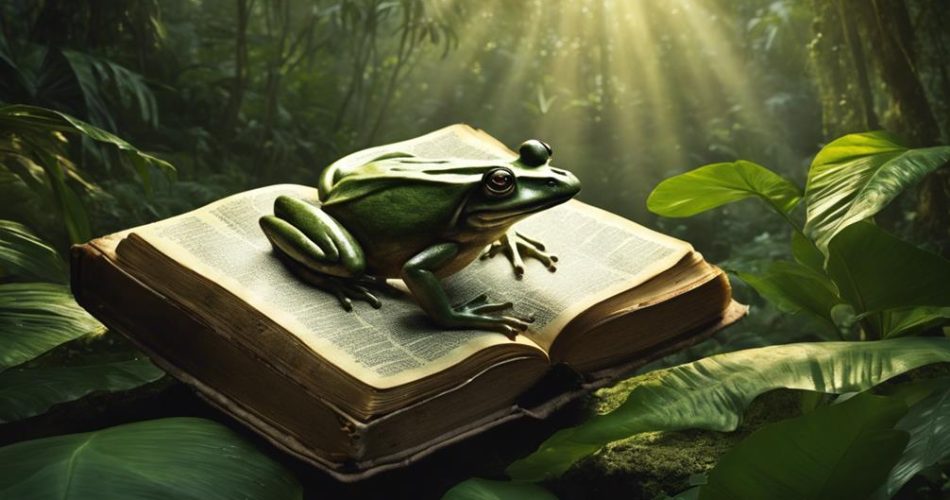Now, you'd be forgiven for thinking that Goliath, the infamous giant from the Bible, had a pet frog that he named after himself. However, the Goliath Frog, the world's largest, is not documented in the biblical text.
Yet, the Bible does mention frogs quite a few times, often symbolizing unclean spirits or plagues. These references raise fascinating questions about the potential symbolism and interpretations connected to this gigantic amphibian.
But how might this tie to theological discussions? Well, let's further uncover these connections together, shall we?
Key Takeaways
- The Goliath Frog's immense size and resilience may symbolize strength and overcoming adversity in biblical contexts.
- Biblical references to frogs typically symbolize unclean spirits, as noted in the Book of Revelation.
- Frogs' symbolic meanings vary across different cultures, from fertility symbols to harbingers of prosperity.
- Conservation efforts for the endangered Goliath Frog could be viewed as a religious stewardship of God's creation.
Understanding the Goliath Frog
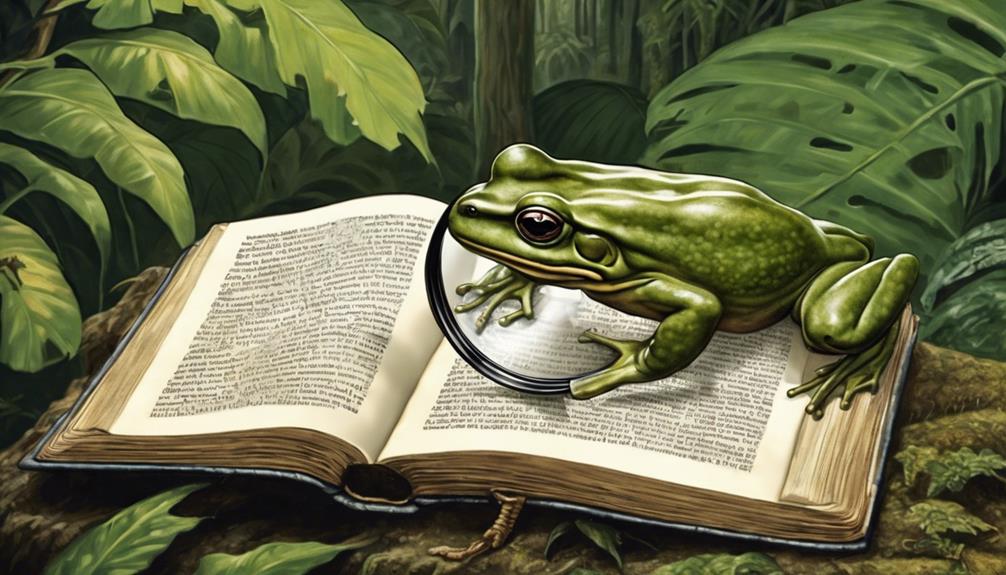
To fully grasp the significance of the Goliath frog in biblical context, you must first understand its unique biological characteristics and ecological role. The Goliath frog, scientifically known as Conraua goliath, is the largest existing frog species in the world. Besides its astonishing size, its lifespan, which ranges from 15 to 21 years, further sets it apart from other amphibians.
Due to its distinctive traits, the Goliath frog plays a pivotal role in its ecosystem. Its diet primarily consists of insects and small crustaceans, maintaining a crucial balance in the food chain. Moreover, its large body size becomes a substantial source of nutrients upon death, enriching the soil and benefiting the overall ecosystem.
However, the Goliath frog's exceptional characteristics and ecological benefits make it a prime target for human exploitation. Frog conservation becomes a critical concern as their numbers dwindle due to overhunting and habitat loss. Efforts towards Goliath frog conservation are increasingly necessary to ensure the survival of this unique species and its continued role in the ecosystem.
Understanding the Goliath frog's biological attributes, ecological role, and the threats it faces underlines the urgency for effective frog conservation strategies, and provides a deeper context for its biblical references.
Biblical References to Frogs
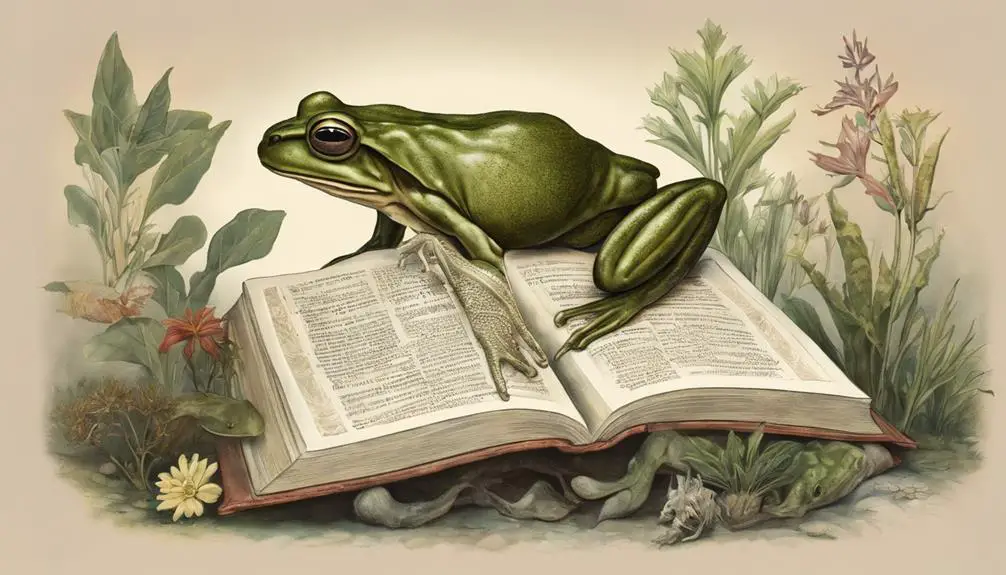
In the Bible, you'll find several intriguing references to frogs, which, when examined carefully, offer profound insights into the ancient world's perception and understanding of these amphibians. Frogs certainly weren't an anomaly in biblical times; they were part of the natural environment and, as such, their identities were well-known.
Notably, you'll find that 'Frog Plagues' in the Bible are a significant mention. The second plague in Egypt involved frogs, as described in Exodus 8:1–15. Here, God commands Moses to tell Pharaoh to let His people go, or He will plague Egypt with frogs. This event is a prominent demonstration of God's power and authority.
| Biblical Reference | Description |
|---|---|
| Exodus 8:1–15 | Frog Plague in Egypt |
| Psalm 78:45 | Recounts the plagues, including frogs |
| Psalm 105:30 | Another recounting of the plagues |
| Revelation 16:13 | Frogs symbolize unclean spirits |
| Revelation 16:14 | Frogs are demonic spirits |
In Revelation 16:13–14, frogs become symbolic, representing unclean spirits and demons. These 'Frog Identities' underscore the Bible's use of frogs as symbols to convey deeper spiritual truths. Reflecting on these references, it's clear that frogs held a significant and complex place in biblical narratives and symbolism.
Interpretations of the Goliath Frog
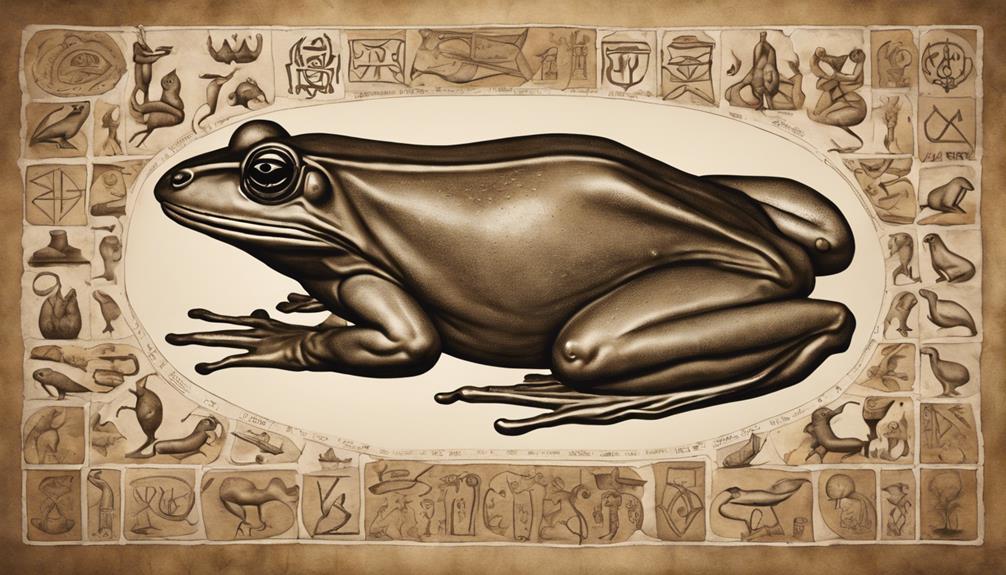
While there are no direct references to the Goliath Frog in the Bible, scholars often interpret its significant size and unique attributes within a biblical context. The Goliath Frog, named for its colossal size akin to the biblical giant Goliath, is believed by some to symbolize immense strength and resilience, qualities often associated with biblical figures.
In your study of the Goliath Frog, it's crucial to consider the importance of its habitat. Goliath's habitat is typically near fast-flowing rivers and streams in the rainforests of Western Africa, a region that's rich in biodiversity but increasingly under threat due to human activities. This highlights the urgent need for Frog Conservation efforts to protect this unique species and its habitat.
The Goliath Frog's impressive size, paired with its ability to thrive in such a challenging environment, might be interpreted as a symbol of overcoming adversity. The biblical narrative often highlights triumph in the face of adversity, and in this light, the Goliath Frog could be seen as a living embodiment of this message.
Symbolism of Frogs in Theology
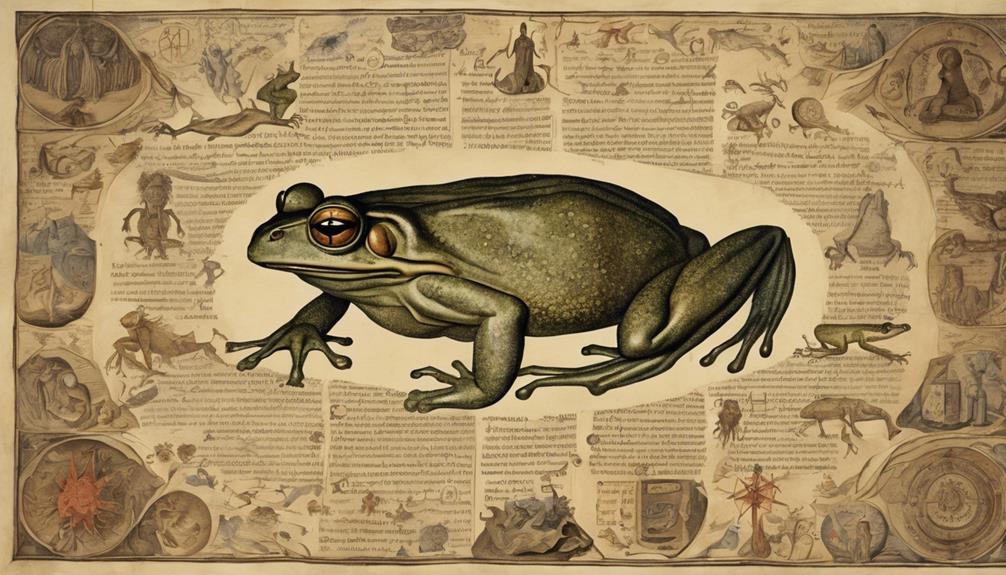
Shifting our focus slightly, let's explore the broader realm of theology where frogs hold significant symbolic meanings across various beliefs and traditions. You'll find that theological amphibians, particularly the frog, are far from inconsequential in various religious narratives.
Let's consider the ancient Egyptians who practiced Frog Idolatry. They revered the frog, associating it with fertility and resurrection. The Egyptian goddess Heqet, often depicted as a frog, was worshipped for her association with childbirth and fertility.
In Christianity, the frog symbolism is more complex. In the New Testament's Book of Revelation, frogs are portrayed as unclean spirits. This negative connotation, however, doesn't negate the frog's powerful symbolism. It serves as a stark reminder of the potential for spiritual corruption.
In Chinese culture, the frog is linked to the moon and is seen as a harbinger of good fortune and prosperity. It's a stark contrast to the Western interpretations, illustrating how cultural contexts significantly shape theological perceptions.
The Goliath Frog: Fact Versus Fiction
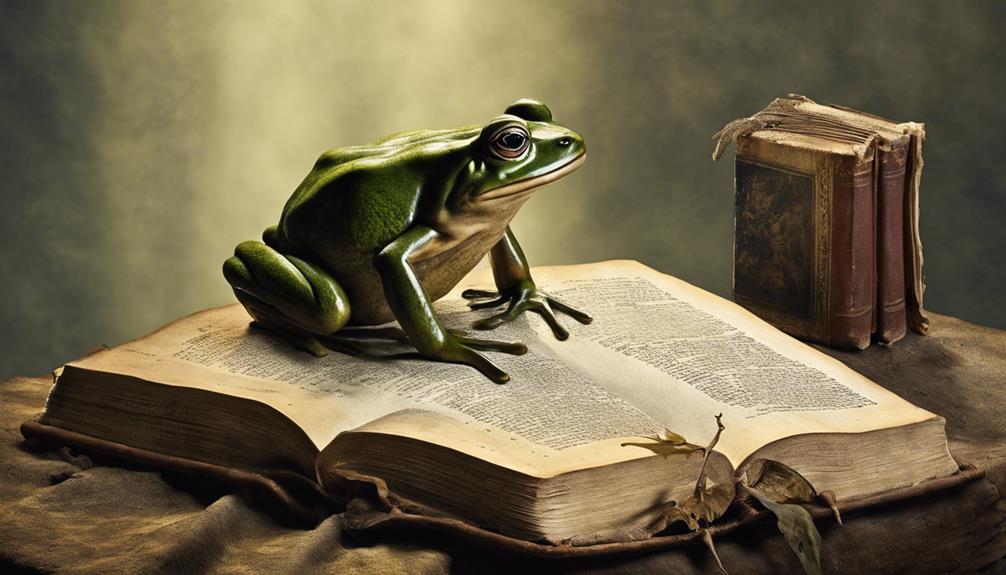
Venturing into the realm of fact and fiction, you'll find the Goliath Frog, an intriguing creature that weaves a fascinating narrative in biblical and scientific contexts. As the largest living frog, it's a primary subject in frog mythology and an exemplar among giant amphibians.
To discern between fact and fiction, let's consider this table:
| Fact | Fiction | Source |
|---|---|---|
| Goliath Frogs can live up to 15 years | They can live up to 50 years | Scientific studies |
| They can leap up to 10 feet | They can leap as far as 30 feet | Frog Mythology |
| They are found in Africa | They are found all over the world | Geographic data |
| They eat insects, fish, etc. | They eat only algae | Dietary studies |
| They are endangered | They are common | Conservation data |
The gulf between fact and fiction is often bridged by myth, but when it comes to the Goliath Frog, it's essential to separate the two. This understanding not only enriches our knowledge of this giant amphibian but also underscores the need for its conservation.
Frequently Asked Questions
What Is the Average Lifespan of a Goliath Frog in the Wild?"
You're curious about the lifespan of a goliath frog in the wild. On average, these massive amphibians can live up to 15 years if their habitats remain undisturbed.
It's a challenging statistic to maintain, however, due to threats like habitat destruction and hunting. That's why frog conservation efforts are so crucial.
They aim to protect these amphibian habitats and ensure the goliath frog, among other species, continues to thrive.
Does the Bible Mention Any Specific Species of Frog, Like the Goliath Frog?"
You're asking if the Bible mentions specific frog species, like the goliath frog.
Biblical interpretations don't specify any particular types. Frogs are symbolic, reflecting plagues in Exodus. They're not identified by their species, so it's unlikely you'll find references to the goliath frog or any other particular kind.
The Bible uses frog symbolism for broader theological messages, not for biological classification or zoological details.
What Do Goliath Frogs Eat and Where Do They Typically Live?"
You'll find Goliath frogs typically in equatorial Africa, particularly Cameroon and Equatorial Guinea. They're often found in fast-flowing rivers with clear water.
As for their diet, it's quite varied. They'll eat insects, crustaceans, fish, and even other amphibians.
Their survival and diet are crucial to amphibian habitats and frog conservation efforts. Loss of habitat and hunting have led to their numbers dwindling, making these efforts ever more important.
Are There Any Cultural or Religious Practices That Revolve Around the Goliath Frog?"
You're asking about cultural or religious practices involving the Goliath frog. While frogs, in general, hold symbolism in various cultures, specific rituals around the Goliath frog aren't widely documented. It's primarily known for its size, not spiritual significance.
Most frog symbolism deals with fertility, transformation, and the like. So, while it's possible some cultures may hold the Goliath frog in particular esteem, there's no widespread ritualistic practice.
Is There Any Scientific Evidence to Support the Biblical References of Frogs?"
You're asking about frog symbolism and biblical interpretations.
While frogs are mentioned in the Bible, particularly in Exodus as one of the ten plagues, there's no scientific evidence to support these biblical references.
It's vital to understand these stories as metaphoric or symbolic.
Thus, there's no concrete scientific correlation between the biblical frogs and actual frog species.
It's an intriguing topic, but remember, religion and science often operate on different planes.
Conclusion
In sum, you've journeyed through an exploration of the Goliath frog in biblical contexts, discovering its symbolic importance in theology.
You've untangled fact from fiction, understanding the interpretative role of this colossal amphibian.
Remember, the Bible's depiction of frogs, including the Goliath, is metaphorical rather than literal.
So, while the Goliath frog doesn't physically appear in scripture, its essence – as understood through the broader symbolism of frogs – holds spiritual resonance.


